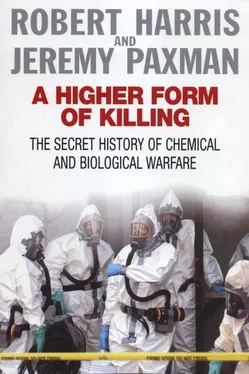Mustard gas.
The scene was once again Ypres. At 10 pm on the warm summer evening of 12 July, the British 15th and 55th Divisions came under heavy bombardment. The enemy was using 77 and 105 mm gas shells in massive numbers. But what they delivered was not ‘gas’ in the sense that the soldiers were used to. It was a brown liquid, rather like sherry, which gave off a smell variously described as ‘unpleasant’, ‘oily’, ‘like garlic’ and ‘like mustard’. Apart from a slight irritation to the eyes and throat, there were no initial effects, and few men even bothered to put on their gas masks. Most quickly went back to sleep. But in the early hours of the morning they began to wake up with ‘intolerable pain’ in the eyes, which felt as though sand or grit had been rubbed into them. Then they began to vomit uncontrollably. As the night wore on, the pain in the eyes became so intense that many had to be given morphia. The following day the sun rose over an army that looked as if it had been stricken by some biblical plague.
When some of the milder cases were evacuated each man had to be led like a blind man by an orderly to the ambulance car.
The face was frequently congested and swollen, especially in the more severe cases, and small blisters were visible in many cases on the lower part of the face and chin, and sometimes on the back.
A few cases had painful patches of blisters on the backs of the thighs and buttocks, and even on the scrotum, with oedema of the scrotum and penis. The vesication of the buttocks and oedema of the genitals would appear to be probably due to men sitting on the ground contaminated with the toxic substance. 33
The hours passed and the symptoms grew worse. Moist red patches of skin affected by the vapour became massive yellow blisters up to a foot long. The gas could easily penetrate clothes, attacking the skin wherever it was most sensitive: at the bend of the elbow, the back of the knee, the neck, between the thighs. The Chemical Adviser to the Fifth Army, trying to retrieve fragments of the mustard shells for analysis, developed blisters on his wrists and on the backs of his hands. He tried to carry a portion of a shell under his arm and developed blisters on his chest, the mustard working its way through several layers of clothing. ‘Owing to its high boiling point,’ reported the War Office expert Sir Harold Hartley, ‘some of it is scattered on the ground and continues to give off gas for some time. It could be smelt in Ypres on the day following the bombardment.’ 34
The field hospitals were choked with casualties. Two days after the attack, the first deaths occurred. Dying was a slow and agonizing process. It was not necessarily the burns that killed, but the havoc the gas wrought in the throat and lungs. ‘On entering a ward full of cases gassed during the recent attack,’ reported Captain Ramsay of the RAMC ‘one is struck by the incessant and apparently useless coughing of the patients.’ 35The men’s bronchial tubes were stripped of their mucous membrane by the gas. ‘In one case,’ wrote another medical officer, ‘the mucous membrane formed apparently a complete cast of the trachea.’ 36The victim died with his windpipe clogged from top to bottom.
There is no record of the precise circumstances in which Sapper Guest of the Royal Engineers was gassed on 12 July. We know only that he was admitted to hospital nine days later and ‘complained of difficulty in breathing and pain in both eyes’. The following day, ‘during the early morning the difficulty in breathing became more marked. He rallied slightly but relapsed in the early forenoon and died at 10 am.’
The body was examined four and a half hours after death. It was that of a well-developed man, and showed externally a slightly dusky discolouration of the skin of face and neck and vesicles on the scrotum and penis but no wounds of any kind. On opening the body, distinct irritation of the eyes, mouth, throat, nose and skin of the face was noticed by several people who were present and a faint sweetish taste was noticeable, comparable with the effect of a weak carbolic solution. 37
Here was a gas so powerful that men standing around the dismembered corpse of a victim at an autopsy could still feel its effects ten days after the initial poisoning. And as the post mortem continued, the full extent of the damage wrought by the gas lay revealed before the doctors. The larynx and vocal chords were ‘swollen and very red’, the windpipe filled with ‘thin frothy fluid’, and ‘six ounces of blood stained fluid in the left lung’; the lung itself, which was more than double its normal weight, ‘felt very firm and solid’, and ‘portions of the lobe sank in water’; the heart weighed twenty ounces instead of the normal ten, and the veins over the surface of the brain ‘contained innumerable small bubbles of gas’.
Another victim, thirty-nine-year-old Lieutenant Collinge of the King’s Liverpool Regiment, took ten days to die:
Brownish pigmentation present over large surfaces of the body. The forearms showed the same pigmentation, except at a place where a wrist watch had been situated, a white ring of skin being present there. Marked superficial burning of the face and scrotum. The whole of the trachea and lower part of the larynx, including the vocal chords, were covered by a yellowish membrane. The bronchi contained abundant pus. The right lung showed extensive collapse, and on section numerous patches of broncho-pneumonia, some as large as a five-shilling piece. These patches were grey in colour, and in many of them the pus could be seen to have extended beyond the limits of the bronchi to form definite abscesses. Liver congested and somewhat fatty. The brain substance was unduly wet and very congested.
Collinge and Guest were only two of hundreds. The Germans had delayed their attack until they had built up enormous reserves of mustard gas and were in a position to mount a bombardment on a giant scale. In ten days Allied positions were pounded with more than a million shells containing 2,500 tons of gas. Within three weeks of introducing Yellow Cross shell, the Germans had caused as many gas casualties as had resulted from the entire gas shelling of the preceding year. By the end of the first week, the number of gassed men admitted to British Medical Units was 2,934; by the end of the second week, a further 6,476 had been added; by the end of the third week, another 4,886.
In all, from July 1917 to the end of the war, British casualties from mustard gas amounted to at least 125,000–70 per cent of the total number of British gas casualties for the whole war. A conservative estimate of the number of deaths was 1,859. Although the mortality rate was therefore only around 1½ per cent, the severity of the effects was enough to keep a man away from duty for two to three months, if not longer. There were frequently secondary infections of the respiratory system and the skin. First World War doctors noted that healing skin could often erupt in fresh blisters, or inflammation could occur in an area which had been previously thought not contaminated. Ramsay gave an instance of a man who ‘had burns of the scrotum on the second day, and on the eighth day the skin of his back became inflamed for the first time.’ 38
Thousands of men were drawing disability pensions at the end of the war as a result of mustard gas poisoning. It was, declared a secret British assessment of gas casualties prepared in 1919, ‘in a class by itself so far as casualty producing power is concerned’. It was not simply a matter of deaths and numbers wounded, it was the time it took for them to heal. ‘To put the matter bluntly, mustard gas on several occasions accounted during a week or two for the prolonged removal from the sphere of active operations of casualties equivalent in number to the combatants of two of more Divisions.’ 39Thanks largely to mustard gas, in the last eighteen months of the war, one casualty in every six (16½ per cent of the total) was a victim of chemical weapons. 40
Читать дальше












